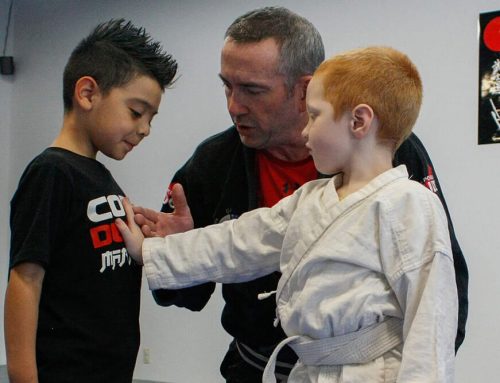Discipline is probably not the first thing on an instructor’s mind when they set out to implement a suitable curriculum for primary aged students. I know it isn’t where my mind went when developing our Mat Monkeys curriculum. And if the instructor is of a certain age, like I am, they might regale you with stories of how discipline was administered when we were young.
Times certainly have changed, but parents ask now, as they did then, what benefit(s) will training Martial Arts provide their child? Inevitably the answer is DISCIPLINE. Let’s not forget the meaning of the word “Martial Art”. The objective of our Mat Monkeys program is physical education, but our method is by drilling military order.
In my experience, primary aged children do best with structured routine and clearly established guidelines. All children enjoy play and exploring. Children will inevitably want to explore the classroom and its established order. And what child doesn’t prefer their wants over other’s needs.
An instructor is responsible for the health, safety, and enjoyment of all participants in class. In a well-regulated class, participants are “self-disciplined” and “focused” on that day’s lesson or objective. From time to time a student may want to “explore” classroom boundaries. Additionally, or alternatively, sometimes young children can become hyper-focused on their feelings. When that occurs, instructors must reestablish classroom order and discipline.
But this is often a sticky-widget and young, less experienced instructors often struggle when disciplining students. Maybe the student didn’t understand the expectations or perhaps the correction was a shock or upsetting for the student. Now the instructor is faced with what seems like a no-win scenario. Lose control of the classroom, or possibly lose the heart and mind of a student that needs our help.
What I want to remind new instructors here is that what comes before and after discipline is just as important as the discipline itself. There are three components to maintaining order in the classroom: RAPPORT, DISCIPLINE and REHABILITATION.
RAPPORT
Establishing rapport with primary-aged children is crucial for various reasons, as it forms the foundation for positive relationships and effective interactions in educational, social, and emotional contexts.
Rapport creates a sense of trust and safety. When children feel comfortable and secure around adults, they are more likely to express themselves, share their thoughts and feelings, and seek help when needed. This trust is essential for their overall well-being.
Building rapport enhances communication. Effective communication is vital for conveying information, teaching new concepts, and resolving conflicts. When children feel connected to their teachers or caregivers, they are more open to listening, asking questions, and participating in discussions.
Rapport helps adults provide emotional support. Primary-aged children may encounter various emotions and challenges. A strong rapport allows adults to understand and address these emotions, helping children develop emotional resilience and coping skills.
Children are more motivated to learn and engage in activities when they have a positive relationship with their teachers or mentors. Building rapport can make learning more enjoyable and meaningful for them.
When adults have a good rapport with children, it becomes easier to manage behavior in a positive way. Children are more likely to follow rules and guidelines when they respect and trust the authority figure.
Building rapport facilitates problem-solving. Children are more likely to approach adults with problems or conflicts when they feel connected to them. This allows adults to help children develop problem-solving skills and navigate social interactions effectively.
A positive rapport with adults can boost a child’s self-esteem and self-concept. Feeling valued and appreciated by significant adults in their lives can contribute to a positive self-image.
Interactions with adults who model positive social behavior can help children develop essential social skills. A strong rapport can provide a safe environment for practicing these skills.
Building rapport with young students can lay the groundwork for long-term relationships. These relationships can extend into higher education, and beyond, serving as a source of ongoing support and mentorship. These connections require patience, empathy, and active listening, but the benefits for both children and adults are well worth the effort.
DISCIPLINE
Disciplining primary-aged children can be a challenging but essential aspect of parenting and education. Effective discipline aims to guide children’s behavior, teach them important life skills, and help them develop a sense of responsibility and self-control. Here are some key principles and strategies for disciplining primary-aged children:
- Clear Expectations: Establish clear and age-appropriate rules and expectations for behavior. Children need to know what is expected of them, and consistency is crucial in enforcing these rules.
- Positive Reinforcement: Encourage positive behavior through praise and rewards. When children exhibit good behavior, acknowledge, and praise them for it. Positive reinforcement can motivate them to continue behaving well.
- Consequences: Define logical consequences for misbehavior. Consequences should be related to the misdeed and should provide a learning opportunity. For example, if a child doesn’t clean up their toys, they may lose some playtime.
- Time-Outs: Time-outs can be an effective strategy for calming children down and giving them a chance to reflect on their behavior. The time-out should be brief and focused on teaching, not punishment.
- Model Appropriate Behavior: Children often learn by observing adults. Model the behavior you expect from them, including how to handle difficult situations and emotions.
- Effective Communication: Talk to children about their behavior and the reasons behind your rules. Encourage them to express their feelings and listen actively to what they have to say.
- Consistency: Be consistent in applying discipline. Inconsistency can confuse children and make it harder for them to understand the consequences of their actions.
- Avoid Physical Punishment: It’s generally recommended to avoid physical punishment.
- Natural Consequences: Sometimes, allowing children to experience the natural consequences of their actions can be a valuable learning experience. For example, if a child refuses to wear a coat on a cold day, they may get cold, which can teach them the importance of dressing appropriately.
- Problem-Solving: Encourage children to be part of the problem-solving process. Help them identify alternative behaviors and solutions to avoid repeating the same mistakes.
- Flexibility: Be flexible and willing to adapt your discipline strategies based on your child’s individual needs and temperament. What works for one child may not work for another.
- Time and Patience: Discipline takes time and patience. Children will make mistakes, and it’s important to provide them with opportunities to learn and grow from those mistakes.
Remember that discipline should be about teaching and guiding children, not punishing them. It’s important to maintain a loving and supportive relationship with your young student while also helping them develop the skills they need to become responsible and well-behaved individuals.
REHABILITATION
After disciplining primary-aged children, it’s essential to focus on their rehabilitation or the process of helping them understand and learn from their actions while maintaining a positive and supportive relationship. Here are some steps to consider when rehabilitating children after discipline:
Following a disciplinary action, take the time to reconnect with the child emotionally. Offer a hug or reassuring words to let them know that your love and support for them remain unchanged.
Encourage the child to think about their behavior and its consequences. Ask open-ended questions to help them express their thoughts and feelings. For example, “Can you tell me why you made that choice?” or “How do you think your actions affected others?”
Help your student understand the concept of responsibility. Talk about how their actions have consequences and how they can take responsibility for their behavior by making amends or choosing differently in the future.
If your student’s behavior has harmed someone else, guide them in offering a sincere apology. Teach them how to express regret and make amends. Modeling this behavior can be especially helpful.
Work with the child to brainstorm alternative ways they could have handled the situation or made a better choice. Encourage them to think about what they could do differently next time.
Acknowledge and praise your student when they exhibit positive behavior or make responsible choices. Positive reinforcement can motivate them to continue making better choices.
Ensure that your expectations for your student’s behavior are age-appropriate. Young children are still learning self-control and may require more guidance and reminders.
If consequences were established as part of the discipline process, make sure to follow through consistently. Be clear about the conditions under which the consequences will end.
Keep the lines of communication open with your students. Encourage them to come to you if they have concerns or if they encounter difficult situations in the future.
Rehabilitation takes time and patience. Be consistent in your approach and understand that behavioral changes may not happen overnight. Remember that the goal of rehabilitation after discipline is to help children learn from their mistakes and make more responsible choices in the future. It should be a constructive and supportive process that fosters their personal growth and development. Building a strong parent-child relationship based on trust and understanding is key to successful rehabilitation.
CONCLUSION
Effective discipline should aim to teach children about appropriate behavior, self-control, and responsibility rather than simply punishing them. It should also be rooted in love, understanding, and a commitment to their well-being. It’s essential to maintain open communication with your students and adapt your approach as they grow and develop. If you’re struggling with discipline issues in your class, seek out help and guidance from more experienced instructors. Sometimes a child’s behavior is outside our scope and the curriculum of our class. If you have concerns be sure to share those with parents and/or guardians but be prepared with referrals to resources such as child occupational therapist, child psychologist or parenting coach.
If you have suggestions, recommendations, or referrals, be sure to share them in the comments below.






